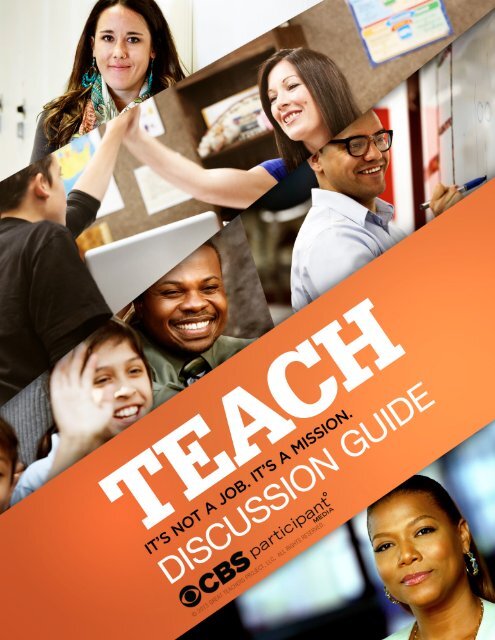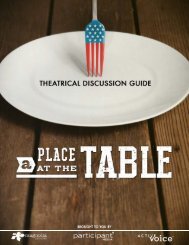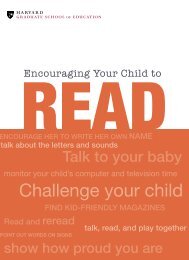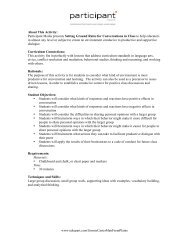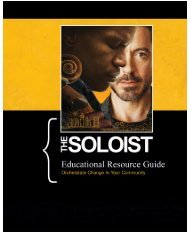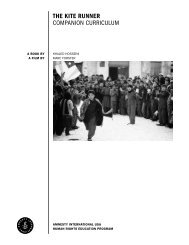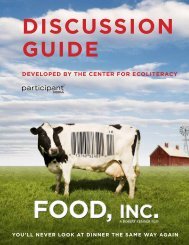teach - TakePart
teach - TakePart
teach - TakePart
You also want an ePaper? Increase the reach of your titles
YUMPU automatically turns print PDFs into web optimized ePapers that Google loves.
TEACHTABLE OF CONTENTSHow to Use this GuideLetter from the DirectorAbout the FilmKey Statistics / About the IssuesAbout the CampaignTips for Hosting a Successful EventViewing GuidelinesBefore ViewingWhile ViewingAfter ViewingQuestions for Further DiscussionTake ActionResources12-33-44556-1168910-1112-1314-15
TEACHHOW TO USE THIS GUIDEThis discussion guide is intended for students, parents, educators, administrators, andgeneral audiences interested in organizing or facilitating a screening of the documentaryTEACH. The guide can be implemented in community screenings, workshops, or houseparties, and can easily be adapted for use at home, in the classroom, or for a professionaldevelopment workshop. Each suggested activity has been created to facilitate dialoguesurrounding the issues explored in this 90-minute documentary special.Every member of the community has a role to play in supporting our <strong>teach</strong>ers, and in turn,keeping public education strong, vibrant, and innovative for every American child. Thereis a substantial amount of information in this guide, so it is up to the host or facilitatorto decide which activities are most useful and relevant for his or her event. Facilitatorsshould consider audience, timeframe, and venue as they read through this guide.The “Viewing Guidelines” section offers activities for groups, families, or individualsbefore, during, and after watching the film. These activities are opportunities for viewersto make connections between the documentary and their own experiences, as well asto encourage a robust conversation. For screenings that are accompanied by a paneldiscussion, material from the “Questions for Further Discussion” can be used to promptthoughtful dialogue. Because one of the primary objectives of the film is to inspire reallifechange, there is a comprehensive section that can help each of us make a difference,by giving back to our local <strong>teach</strong>ers, helping students, and supporting local educationalcommunities - both individually and through established organizations. By engaging withthis guide, audiences will deepen their understanding of the film’s content, and will beprovided with the tools to help turn inspiration into action. Participants can also accessthe official website, www.takepart.org/<strong>teach</strong>, to learn more about inspiring the nextgeneration of great <strong>teach</strong>ers – and even find out how you can become a <strong>teach</strong>er yourself!PAGE 1
TEACHLETTER FROM DAVIS GUGGENHEIMIt is More than a Job: It is a MissionSure, we all know what a <strong>teach</strong>er is. We spent years sitting in classrooms being moldedby them. But those impressions can distract us from truly understanding the role.What makes the job so important? What qualities make <strong>teach</strong>ers effective? Ask 50different people and you’ll likely get 50 different answers. TEACH aims to shine a lighton the subject, giving this most heroic of professions the attention it sorely deservesand celebrating the men and women on the front lines in what is one of the mostmisunderstood and yet most important roles in our society.Some <strong>teach</strong>ers are inspirational, some practical; some focus on details, others give us abroader perspective. I was a terrible student who was saved from mediocrity by a few<strong>teach</strong>ers who saw the best in me and changed the course of my life. So I know firsthandhow transformative a <strong>teach</strong>er’s influence can be on a student’s life. Being an educator is atough job. Some say it’s an art, some say it’s a science, and in TEACH we come to see that itis both.The simultaneous promise and tragedy of our American schools have long been a focusfor me. I kicked off my documentary career in 1999 with THE FIRST YEAR. The filmchronicled the stories of five first-year <strong>teach</strong>ers in some of America’s toughest schools. In2010, with the backdrop of having to take my own kids out of public school, I looked at theshocking flaws in our public education system and how it affected the lives and dreamsof these five kids and their families in WAITING FOR “SUPERMAN.” But where WAITINGFOR “SUPERMAN” centered on the crisis in public education, TEACH turns the focus toits brightest promise: the <strong>teach</strong>ers. Most moms and dads believe every kid in Americadeserves great public schools, but the issue is so complex and sometimes feels impossible.With TEACH, I wanted to show that there are great <strong>teach</strong>ers in every school fightingthe good fight and doing whatever it takes for their kids. They are at the heart of what’sworking. Maybe, if we could find and support more <strong>teach</strong>ers like this, all of our schoolswould be great.Our September 6 th broadcast could not be more timely. It is estimated that 50% ofAmerica’s <strong>teach</strong>ers will retire over the next ten years. I hope TEACH will help advance thenational discourse on public education and, beyond that, move people to respect <strong>teach</strong>ingas a top profession and vital career choice. America needs to recruit its next generation ofpassionate <strong>teach</strong>ers, and I hope that TEACH in its own small way inspires people to realizethis is a tough, demanding, deeply meaningful job where the stakes are extremely highand the rewards are infinitely rich.PAGE 2
TEACHHopefully, millennial viewers will appreciate the film’s honest, authentic, no-holds-barreddepiction of <strong>teach</strong>ing. From research, we know young people want their work to havemeaning and here they will see <strong>teach</strong>ing is something a smart, tech-savvy, engaged personcan do. What can be more meaningful than making a difference in the lives of others andour world at large? To put it simply: I believe there is nothing more urgent than recruitingour best and brightest to be in front of our classrooms.Education is at the core of the American dream. It’s a pathway to success and a key to afuture of hope and opportunity. The <strong>teach</strong>er is the key that unlocks that door. It is time toelevate and promote the profession, as well as engage new <strong>teach</strong>ers and support currentones.Davis Guggenheim, DirectorTEACHABOUT THE FILMIt is estimated that within the next 10 years, 50% of America’s <strong>teach</strong>ers are eligible forretirement. With this staggering fact in mind, Academy Award ® -winning documentarianDavis Guggenheim has decided to ask a timely question: What is a <strong>teach</strong>er? The answer isTEACH, a rare glimpse inside four public-school classrooms filmed over an entire schoolyear through the eyes, hearts, and minds of four inspirational <strong>teach</strong>ers.As intense as it is emotional, this year-in-the-life of four public-school <strong>teach</strong>ers illustrateshow tenacity, passion, and a belief in innovation drive these educators as they navigatethe daily ups and downs of the 2012-2013 school year. Viewers are taken on a journeyinside the classrooms of: Matt Johnson, a fourth-grade <strong>teach</strong>er at McGlone ElementarySchool in Denver, Colorado; Shelby Harris, a seventh-grade math <strong>teach</strong>er at Kuna MiddleSchool in Kuna, Idaho; Lindsay Chinn, a ninth-grade algebra <strong>teach</strong>er at Martin Luther KingJr. Early College, also in Denver; and Joel Laguna, a tenth-grade AP World History <strong>teach</strong>erfrom Garfield High in Los Angeles, California. These educators use conventional andunconventional methods and do whatever it takes to overcome obstacles and strive forsuccess.For the viewer, TEACH is a chance to rethink and explore exactly what it means to be a<strong>teach</strong>er, to look at the tough and complicated job of <strong>teach</strong>ing as a profession, examiningin real time what it takes to reach their kids. In celebrating <strong>teach</strong>ers and <strong>teach</strong>ingeverywhere, it is a call to action for viewers to recruit and inspire the next generation ofeducators.PAGE 3
TEACH“This is more about what’s working in education,” Guggenheim says. “Most moms anddads believe every kid in America deserves great public schools, but the issue is socomplex and sometimes feels impossible. With TEACH, I wanted to show that there aregreat <strong>teach</strong>ers in these schools fighting the good fight and doing great. They are at theheart of what’s working. If we could find and support more <strong>teach</strong>ers like this, we wouldhave great schools.”As the film demonstrates, at the heart of academic success are <strong>teach</strong>ers whose deepdevotion to their jobs makes the difference. We see them digging deep to help studentslike Yeira, a bright-eyed fourth-grader struggling to make up a three-year shortfall in herreading skills; or Samy, a ninth-grader who wants to be a pilot but has all but given up ongrasping the math that is a prerequisite to realizing that dream.“The idea is to recruit the next generation of passionate <strong>teach</strong>ers,” he says. “I hope the filminspires people to realize this is a tough, demanding, deeply meaningful job where thestakes are extremely high and the rewards are infinitely rich.”KEY STATISTICS / ABOUT THE ISSUES• There are over 4 million <strong>teach</strong>ers in the United States. Almost half of them areunder 40 years of age. Almost 80% of them are white, and 75% are women.• The average American classroom has one <strong>teach</strong>er and 25 students.• The average <strong>teach</strong>er’s salary increased only 3% between 1990 and 2010.• Almost 50% of all new <strong>teach</strong>ers will quit <strong>teach</strong>ing within their first five years in theclassroom.• Close to 60% of the <strong>teach</strong>ing work force will be retiring within the next 10 years.SOURCE: U.S. Department of Education, National Center for Education Statistics. (2012). Digestof Education Statistics, 2011 (NCES 2012-001), Introduction and Chapter 2 ; U.S. Department ofEducation, National Center for Education Statistics, Schools and Staffing Survey, Teacher Data Files,2007–08.PAGE 4
TEACHABOUT THE CAMPAIGNThe goal of the Social Action campaign is to reframe and elevate the profession of <strong>teach</strong>ingwhile engaging potential new <strong>teach</strong>ers and supporting current <strong>teach</strong>ers. Takepart.com/<strong>teach</strong> will provide opportunities to explore innovations and great <strong>teach</strong>ing happening inthe classroom today, show more about how one can support <strong>teach</strong>ers in the community, aswell as how to become a <strong>teach</strong>er. The campaign will consist of online and offline grassrootsactivities to build awareness and recruit the next generation of <strong>teach</strong>ers.Please visit www.takepart.com/Teach to learn more.TIPS FOR HOSTING A SUCCESSFULVIEWING OF TEACHHosting a viewing of TEACH is a great way to initiate a thoughtful exploration of America’seducation system through the eyes, minds, and hearts of its most essential resource –<strong>teach</strong>ers. Your event might be an informal house party, an independent study assignment,a formal classroom lesson, or an evening program or professional development workshop.TEACH can be viewed in a variety of settings, with more or less facilitation, dependingon your objectives and audience. Hosting a house viewing party is a great way to makethe most of the film during its initial broadcasts (September 6, 2013 at 8pm on CBS,September 18, 2013 at 8pm on Pivot). Subsequently, when the film becomes available oniTunes (September 18, 2013), other contexts, such as community screenings, classroomuse, or professional development workshops become more feasible. The film itself is90 minutes, and whether or not the event is a house party to watch the broadcast, or amore formal educational event, hosts should allow an additional 30 to 45 minutes for afollow-up discussion. With larger groups, consider having a moderator. Your discussionmight also benefit from including local experts or stakeholders to discuss the content andaddress audience questions. Local experts could include: classroom <strong>teach</strong>ers, schooladministrators, community organizers, parents, and students. Other kinds of events toconsider are: a separate, follow-up session for participants to work on an action agenda;a workshop for a longer, more informal and participatory event; or a class or classroomactivity that spans multiple class periods. Whatever you decide, we’d love to hear aboutyour event. Please share anecdotes, pictures, and/or videos from your event with us onour Facebook page at Facebook.com/TeachMovie and we may showcase them on our website.PAGE 5
TEACHVIEWING GUIDELINES FOR TEACHTEACH is a point of departure for a larger conversation about one of our most preciouscommunity resources: our <strong>teach</strong>ers. The film is meant to be discussed, not just watched.In this vein we provide the following guidelines for a facilitated viewing of the film TEACH.While many of the procedures that follow lend themselves seamlessly to a more formaleducational context, we encourage hosts to pick and choose the activities and discussiontopics that are relevant, even for small groups in a relaxed setting. These guidelinescan be used in many ways with a variety of audiences: with friends and neighbors at anin-home viewing party, or as part of a course or workshop with pre-service <strong>teach</strong>ers,in-service <strong>teach</strong>ers, parents, students, and others. The pre-viewing activities are meantto prepare viewers to look for specific topics and themes as they watch the film. Postviewingdiscussions can help transform participants from passive viewers into activethinkers, as the discussions provide a multitude of ways for viewers to engage criticallywith the show’s material. If your event is a more formal one, try to watch the film yourselfand create a list of the main points for post-screening discussion. This will help you be anactive, engaged, and prepared facilitator.Before Viewing1. Before starting the film, provide a brief introduction to the film and the issues itraises. Refer to the sections “About This Film” and “Key Statistics” in this guide fora general description. Then, communicate some of the central themes that recurthroughout the documentary, including:• Perseverance as a key predictor of success• The instructive value of being challenged• Innovation, technology, and learning• The importance of constructive supervision, coaching, and mentoring in thelearning process• The importance of reflection and assessment in the learning process• Authentic human connections at the heart of <strong>teach</strong>ing and learning• Flexibility, change, and resilience as necessary strategies for success2. On a flip chart or white board, write the following terms:TEACHEDUCATEINSPIRELEARNPAGE 63. In a large group discussion, elicit definitions and associations for each word fromthe group, creating web frameworks for each as you chart their responses on theboard. To guide the discussion, ask participants to consider how each term issimilar, and how they are different.
TEACH4. Explain to the group that these four experiences can sometimes dovetail,sometimes clash, and sometimes overlap for students and <strong>teach</strong>ers in theclassroom. Ask the group to keep these terms in mind as they view TEACH, andto consider how they reveal themselves, and relate to one another, throughout theyear that is documented in the film.5. Before viewing the film, use some or all of the following questions to conducta group discussion. Encourage viewers to draw on their existing knowledge,personal experiences, skills, and assessments of the issues surrounding educationin their responses.• What are some of the values or personality traits that characterize successful<strong>teach</strong>ers who thrive in the classroom?• How might a <strong>teach</strong>er change - both personally and professionally - over thecourse of one academic year? How might this differ with veteran <strong>teach</strong>ers vs.new <strong>teach</strong>ers? How might this change be reflected in their students?• What characteristics do you have that would make you a successful <strong>teach</strong>er?What characteristics do you have which might create challenges for you in theclassroom? Explain.• What would you find to be the most challenging aspect of <strong>teach</strong>ing?• As a parent in the school community, how might you best support a novice<strong>teach</strong>er?• Who are <strong>teach</strong>ers and what do they do?• Overall, what was your educational experience like in elementary, middle, andhigh school? Consider what you loved, what you hated, what worked for youand what didn’t. How does this influence your behavior today as a student,<strong>teach</strong>er, administrator, or parent?• What are some of the reasons people may be inspired to join the <strong>teach</strong>ingprofession? What are some of the reasons highly qualified people might choosenot to become <strong>teach</strong>ers?• What do you think are the biggest challenges facing American <strong>teach</strong>ers today?• How do you learn something new?• In an institutional system that is often fraught with budget cuts, politicalupheaval, and increasing <strong>teach</strong>er turnover rates, what can a <strong>teach</strong>er look forand depend upon for support and inspiration?• Looking back on your own history as a student in the traditional classroom,what could have been done differently within the confines of the classroom thatwould have enriched your experience?• What is the single most challenging thing a student in a classroom faces intoday’s educational climate?• Who was your favorite <strong>teach</strong>er? What did he/she <strong>teach</strong> you, and why was thisclass and this <strong>teach</strong>er so meaningful to you?PAGE 7
TEACHWhile Viewing1. Create a full-sized version of the following chart and distribute a copy to eachviewer. Alternatively, draw the chart on a flip chart or white board, and instructviewers to recreate it on a piece of paper:EvaluateMatt Shelby Lindsay JoelPlanImplementAssessRe<strong>teach</strong>/DifferentiateReflect2. Explain to the group that the terms in the left hand column of the chart representsome of the steps taken by <strong>teach</strong>ers during the course of a unit.3. Allow some time to define the terms with the group:• Evaluate: explore the needs of the students and identify learning objectives• Plan: devise and map clear and innovative lessons to achieve objectives• Implement: <strong>teach</strong> the lessons to the class• Assess: through formal and informal assessments, gauge how successful thelessons were in achieving learning objectives• Re<strong>teach</strong>/Differentiate: revisit the objectives that were not met based on theresults of the assessment. This usually involves devising new lessons anddifferentiating instruction to accommodate students at various levels ofcompetency• Reflect: how successful overall was the unit? What could be done differently?What impact did your <strong>teach</strong>ing have on your students and on yourself as areflective practitioner in the classroom?PAGE 84. Instruct the group to take notes in their chart as they watch the documentary.Viewers should note moments in the film when the <strong>teach</strong>ers implement each stepthat is listed. Notes can consist of thoughts, reflections, questions, comparisons,or observations. Explain to the group that they will be able to refer to this graphicorganizer during a post-viewing discussion.
TEACHAfter Viewing1. At the conclusion of the documentary, allow time for viewers to process whatthey’ve seen. Encourage members of the group to share one question orobservation that they noted on their chart while viewing. Use these comments asprompts to facilitate a short, whole-group discussion.2. Divide the group into four smaller groups of 4-10 people, depending on the sizeof the audience. Assign each small group one of the four <strong>teach</strong>ers featured in thedocumentary: Matt, Shelby, Lindsay, or Joel.Note: For large audiences, consider dividing into eight small groups and assigning twogroups to each <strong>teach</strong>er.3. Allow time for the small groups to discuss their assigned <strong>teach</strong>er. Each groupshould answer the following questions. Questions can be copied and distributedas handouts, projected overhead, or written and posted on chart paper or a whiteboard:• What methods of instruction did your <strong>teach</strong>er use at first? Did his or hermethods change throughout the film?• Give one example of an “innovative lesson” that the <strong>teach</strong>er demonstrated.What made it innovative?• What factors contributed to the <strong>teach</strong>er’s overall success in the classroom?What factors proved to be hurdles to success?• What was the biggest lesson that the <strong>teach</strong>er learned about him/herself duringthe school year?• What was the enduring message that the students received from this <strong>teach</strong>er?• How did the mentors in the film influence the <strong>teach</strong>ers? How did theirguidance impact the students?4. Allow time for small groups to present one of their answers to the whole group,and to discuss these responses as a whole. Ask viewers to consider the followingguiding question as they discuss each <strong>teach</strong>er in depth: How would you characterizethis <strong>teach</strong>er’s personal and professional journey over the course of the academicyear? How was this mirrored in the experience of his or her students?PAGE 9
TEACHQuestions for Further DiscussionIn addition to, or in lieu of, the more formal after viewing activities outlined above, use someor all of the following questions to facilitate an after viewing discussion about the film:• What was surprising about the film? What was expected?• Do you think these four <strong>teach</strong>ers are a representative sampling of the profession?Why or why not?• The director stated that he made careful choices regarding how to portray the “yearin-the-life”of a <strong>teach</strong>er in his documentary. What was behind his strategy? What doyou think he left out in order to simplify his depiction?• How does viewing TEACH change any preconceived notions you may have had aboutthe nuts and bolts of the <strong>teach</strong>ing profession?• How did each <strong>teach</strong>er show perseverance? What about the featured students? Canperseverance, especially in regards to one’s own learning, be taught? Or is it aninnate characteristic?• How well did the filmmakers show the trials and tribulations of the <strong>teach</strong>ingprofession?• It is estimated that billions of dollars are lost each year when promising <strong>teach</strong>ersdecide to quit the profession. How might we improve our system of recruiting andretaining <strong>teach</strong>ers?• In his book, Outliers, Malcolm Gladwell states that it takes 10,000 hours practicinga specific task to truly become an expert in one’s field. This would translate to6-7 years of on-the-job training hours for a <strong>teach</strong>er. Yet statistics show that nearly50% of <strong>teach</strong>ers quit within the first 5 years of <strong>teach</strong>ing. Have you noticed thisphenomenon in your local schools? What impact do you think this has on yourchildren’s education and on your community at large? What do you think your schooldistrict, PTA, school administration, or parent community could do that wouldincrease the likelihood of great <strong>teach</strong>ers remaining in the profession?• Teaching is sometimes referred to as a “noble” profession. Wayne Dyer definesnobility as “…not about being better than anyone else- it’s about being better thanyou used to be.” How did each <strong>teach</strong>er become “better than [he or she] used to be” bythe end of the school year?PAGE 10• What does the documentary tell us about the challenges and benefits of innovative<strong>teach</strong>ing methods?
TEACH• Some might say that <strong>teach</strong>ers are exposed to public scrutiny and disrespect muchmore so than those in other professions. What are some ways that we, as a society,could uplift the <strong>teach</strong>ing profession?• How has the state of education either improved or declined over the past decadesin your community? What do you think is in store for the future of education in ourcountry?• In the film, the narrator states, “The educators use conventional andunconventional methods and do whatever it takes to overcome obstacles and strivefor success.” What methods/<strong>teach</strong>ing tools do the <strong>teach</strong>ers employ throughout thefilm? What are the conventional methods that each of the four <strong>teach</strong>ers employ atone time or another throughout the film? What are the unconventional methods?Which ones are effective, and why?• How do <strong>teach</strong>ers decide when to use traditional vs. non-traditional <strong>teach</strong>ingmethods?• How can parents become more active in their own child’s success in the classroom?How can your community foster a closer relationship between parents, <strong>teach</strong>ers,and students to ensure academic success?• If educators and the educational field were appreciated fully, what would that looklike? How might that change the success of the American educational system?• Mentoring new and veteran <strong>teach</strong>ers is an integral part of the documentary. Whenwatching the film, note how the mentors support/coach their <strong>teach</strong>ers. Whattechniques do the mentors incorporate to both show support for the <strong>teach</strong>ers andhelp the <strong>teach</strong>ers become better practitioners of their craft?• What did you notice about the students in the film? How did their contentarea skills change over the course of the documentary? How did they changeemotionally over the course of the film? How can these changes be traced back totheir <strong>teach</strong>er?• How did the parents feel about their own educational experience? About theirchildren’s?PAGE 11• Fourth-grade <strong>teach</strong>er Matthew Johnson states, “This is where it all starts. If youdon’t have a good foundation, you can’t build anything on top of that, and it’s allgoing to crumble.” What did the parents, educators, and administrators featuredin the film do in order to better insure that ALL students have a strong foundationupon which to build a more hopeful, educated future?
TEACHTAKE ACTIONThe following action prompts can be used by in-service or pre-service <strong>teach</strong>ers, students,parents, and other stakeholders in a variety of contexts -from an independent studyassignment to a formal classroom setting, from an evening program to a half-day workshoptofoster crucial dialogue about the issues surrounding education and educational policiesin America. Through education, awareness, and simple actions, one CAN make a positivedifference.Tell me and I forget. Teach me and I remember. Involve me and I learn.– Benjamin FranklinHOST A SCREENINGOrganize a group to gather together to watch TEACH on September 6, 2013 at 8pm on CBS,or on September 18, 2013 at 8pm on Pivot, and conduct a discussion afterwards. TEACH isan informative and entertaining documentary that captures the challenges and rewards ofthe <strong>teach</strong>ing profession. Use the discussion questions in this Guide to organize an informedconversation afterwards. Check out www.takepart.com/<strong>teach</strong> for more information abouthosting a screening or house party. And if you miss the broadcast, download TEACH fromiTunes starting on September 18, 2013.BECOME A TEACHEREvery day, you can make a difference in the lives of young people, challenge your ownunderstandings of the world around you, and learn new things. Become part of the fabric ofyour community. Become a <strong>teach</strong>er. For more information on how you can take your passionand commitment and turn it into a career, or how you can inspire a young person to go into<strong>teach</strong>ing, visit http://www.<strong>teach</strong>.org/become-a-<strong>teach</strong>er.Be part of the solution!SPONSOR A TEACHERMake a tangible difference in the life of an underserved American student by sponsoringa Teach for America corps member. For more information, and to sponsor a <strong>teach</strong>er, visithttp://www.<strong>teach</strong>foramerica.org/support-us/sponsor-a-<strong>teach</strong>er. And for more ways to getinvolved in TFA’s important work or to receive their newsletter,go to www.<strong>teach</strong>foramerica.org/support-us/take-action.PAGE 12TUTOR A CHILDTEACH highlights the challenges that classroom educators face when the students in theirclasses are at all different levels of competency. Help even out the field by becoming a tutor.Contact a local school, or volunteer through an existing non-profit such as Mentoring.org.Go to http://www.mentoring.org/get_involved/become_a_mentor for more information.
TEACHBE A VOLUNTEERSupport <strong>teach</strong>ers across the country by signing up to be an e-Activist with the AmericanFederation of Teachers. Visit http://www.aft.org/getinvolved/enews.cfm for moreinformation and to sign up.SPEAK OUT ONLINEThere are hundreds of education blogs on the web that would welcome a fresh voice andwhich have the potential to influence the views of many citizens all around the country.Share your insights and experiences as a <strong>teach</strong>er, student, parent, or administrator bysubmitting to an existing blog such as HuffPost Education or CNN’s School of Thought. Letyour voice be heard!SUPPORT A CLASSROOMTeachers around the country are faced with a basic challenge: they don’t have the fundsto implement their innovative classroom approaches. Help a <strong>teach</strong>er change this bysupporting the classroom project of your choice. Visit www.donorschoose.org to pick aproject and donate today.JOIN THE PTAOne of the best ways to advocate for improving education is by joining or establishing anactive PTA. For more information about how to join or start a local chapter,go to http://www.pta.org/about/Join.cfm?ItemNumber=3308.PAGE 13
TEACHRESOURCESAmerican Federation of Teacherswww.aft.orgNational Education Associationwww.nea.orgUS Department of Educationwww.ed.govKhan Academywww.khanacademy.orgNew Teacher Projecthttp://tntp.orgTeaching Channelwww.<strong>teach</strong>ingchannel.orgTeach For Americawww.<strong>teach</strong>foramerica.orgGraphitewww.graphite.orgEducation Revolutionwww.educationrevolution.orgAmerican Association of School Administratorswww.aasa.orgCouncil for Exceptional Educationwww.ces.sped.orgAmerican Educational Research Associationwww.aera.netAssociation for Childhood Education Internationalwww.acei.orgPAGE 14Association for Supervision and Curriculum Developmentwww.ascd.org
TEACHRESOURCES CONT.National PTAwww.pta.orgNational School Boards Associationwww.nsba.orgNational Staff Development Councilwww.nsdc.orgNew Teacher Centerwww.new<strong>teach</strong>ercenter.orgEdmodowww.edmodo.comGooru Learningwww.goorulearning.orgBlended Learningwww.blendmylearning.comThe Teaching Channelwww.<strong>teach</strong>ingchannel.orgABOUT PARTICIPANT MEDIAParticipant Media is an award-winning global independent entertainment company known forhigh-quality films that inspire social change, such as “The Help,” “Good Night and Good Luck,” “FoodInc.,” “The Cove,” “The Best Exotic Marigold Hotel” and, most recently, “Lincoln” and “A Place at theTable.” Through its films, social action campaigns, digital network <strong>TakePart</strong>.com, and Pivot, its newtelevision network for Millennials, Participant seeks to entertain, encourage and empower everyindividual to take action.ABOUT BIG PICTURE INSTRUCTIONAL DESIGNBig Picture Instructional Design gets all the stakeholders in the educational space talking about - andwatching - movies. As former classroom educators with extensive experience in nonprofit work,educational administration, and media literacy, BPID increases the reach and impactof issue-drivenfilms, television projects, and documentaries by creating custom-designed campaigns and collateralmaterials that always put the film at the forefront. www.bigpictureinstructional.comPAGE 15


